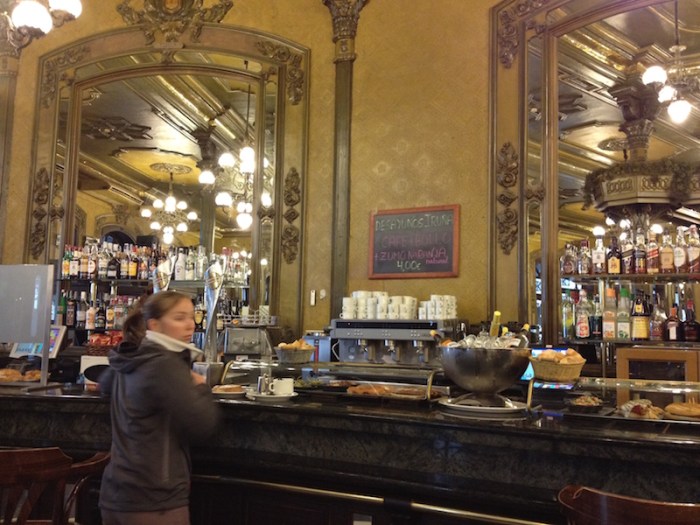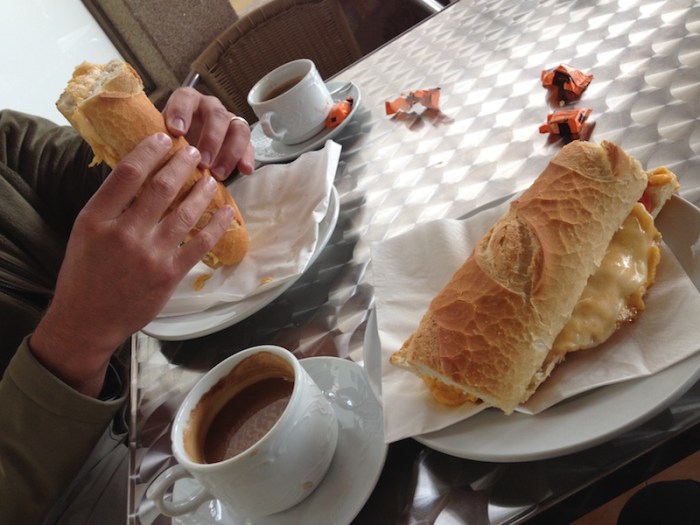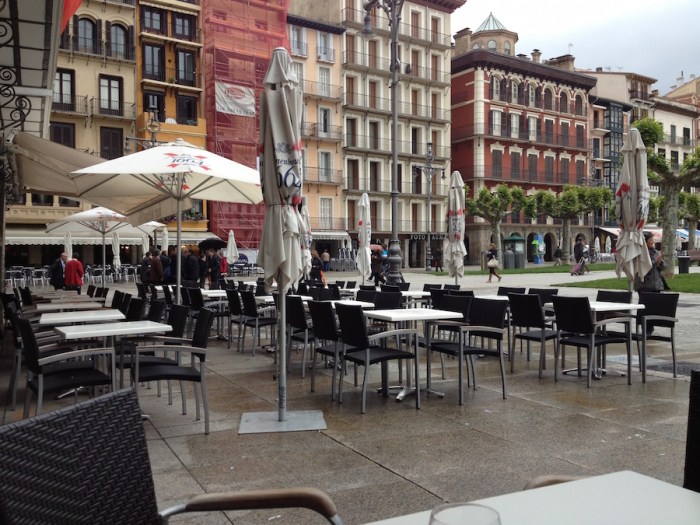My first 3 days in Spain, I was determined to prove that I knew some Spanish. But lo, it was Book Spanish, mostly theoretical in nature and not so useful in the field. I conjugated my face off, tossing off all the subjunctive mood I could muster. I thought I was being extra-polite (and clever) when I stuttered, to pilgrim-weary bartenders, “Good day! How are you this day, Sir? Please might you to have bringded me a coffee alone please? I am thank you so very much!”
Really, this did not make me seem smart. It made me seem annoying. I first grasped this in a strange little bar in Zubiri. The wall-eyed barman glared at me angrily when I opened with, “¿Cómo está Usted?” Get to the point, his searing, bidirectional stare seemed to say. Who cares how I am doing?
I learned this lesson again in a wonderful chocolate shop in Pamplona, packed armpit to armpit with hypoglycemic Navarrans. When it was my turn to shout an order to the saleswoman, she shifted her eyes to me and said, ¡Dime! (the familiar form of “Tell me!) There was no time for niceties. “Give me those things of chocolate!” I managed. Imperative, no subjunctive. Moments later, I was strolling La Calle Estafeta, cramming things of chocolate into my mouth. And I didn’t even get the evil eye.
After that, I learned to do things more Spanishly: State your order without all the time-consuming subjunctive pleasantries. A simple “Buenos días! Café con leche, por favor” will suffice. Or if you want to get a little fancy, “¿Me pone un café con leche?”
Niceties & Other Useful Phrases
por favor—please
*gracias—thank you (*See the bottom of this post for “How to pronounce c and z in Castillian Spanish.)
para llevar—to go
And now, the most fundamental vocabulary you will need to get fed, watered, and caffeinated in the early a.m. on your Camino.
Desayuno—breakfast
Don’t expect to find many big English egg-and-bacon breakfasts, especially in the small towns of Navarra, Castilla y León, and Galicia. So what? What they might lack in variety, they make up for in consistency. What I love about northern Spain is that no matter how small the town, there is almost always a bar, which generally operates as a café first thing in the morning, a tapas and sandwich place until siesta, and a wine/beer/tapas bar thereafter. Most serve some kind of dinner at night, although that may not begin until pretty late, by U.S. dinnertime expectations. (More on Spanish dinner culture in another post.)
When you take your first (and second) breakfast breaks, don’t bemoan what you can’t have. What you can have is some kind of pastry (some mediocre and prepackaged, others homemade and fabulous), nice Spanish bread (the crusty kind, baked nearby), toasted and served with butter and jam or honey, fresh orange juice (but not always), and a fantastic espresso drink  of your choice (always). Sometimes, you might find ham, cheese, or chorizo sandwiches or Spanish tortillas on offer. And in many towns, you may opt to pop into a bakery (panadería) on the way out of town, where you can snag a hot, fresh pastry or baguette for the road.
of your choice (always). Sometimes, you might find ham, cheese, or chorizo sandwiches or Spanish tortillas on offer. And in many towns, you may opt to pop into a bakery (panadería) on the way out of town, where you can snag a hot, fresh pastry or baguette for the road.
Usually, you’ll spend less than 5€—and often, far less than that, as you can see in the menu to the right (at a café in Galicia).
In big cities like Pamplona, Logroño, Burgos, and León, you can get most any kind of breakfast you want. And if you decide to stay in a nice hotel or parador on occasion, you may find yourself breakfasting quite sumptuously.
Here’s an overview of the basic vocabulary you’ll want:
bocadillo—sandwich on a baguette
bollo—roll
churros con chocolate—long, fried sugary doughnuts with hot chocolate (more common in parts further south)
tostada—toast
Ask for your tostada with (“con”):
mantequilla—butter
mermelada—marmelade
miel—honey
**tomate y aceite OR pan tumaca—toast (sometimes rubbed with garlic) and topped with pureed tomato, olive oil, and salt. If this is available, EAT IT RIGHT AWAY.
(**note: As pointed out in the comments below, you can make this yourself in an albergue—our Mad Andalusian Chef friend did, and he even took over the kitchen in an Ages café once to make it for us. Try it at home: Cut a tomato in half, grate the fleshy part into a bowl, mix in some chopped garlic, salt, and olive oil, and spoon it over Spanish-style toast.¡Delicioso!)
tortilla de patata—a delicious eggy/potato-y frittata thing that bears no relationship to its Mexican namesake; unofficially, the official tapa of Spain. Sometimes available for breakfast.
tortilla francesa—an omelette
chorizo—pork sausage seasoned with paprika (usually cured, sometimes fresh)
jamón serrano—dry-cured ham, sliced thin (More on this in another food installment.)
queso (“KAY-soh“)—cheese
Bebidas—beverages
agua—water
un botellín de agua—a small bottle of water
una botella de agua—a big bottle of water
café americano—espresso coffee with hot water, similar to brewed coffee
café bombon—decadent espresso with sweetened condensed milk
café cortado—espresso with a little milk
café con leche—espresso with scalded milk; the unofficial official morning beverage of peregrinos
café solo—plain espresso
café descafeinado—decaf coffee
té OR infusiones—tea
azúcar—sugar
sacarina—fake sugar
zumo de naranja—orange juice. If it says “natural,” it’s freshly squeezed—often, before your eyes in a machine behind the bar. (*note: To those who studied Latin American Spanish: Asking for “jugo” in Spain will get you nowhere.)
Now, spit it out—How to order tea with sugar, without annoying the bartender:
“¿Me pone un té con azúcar?” or simply “un té con azúcar, por favor.” (If he’s busy, maybe don’t ask him how he is doing.)
FAQ:
Why do Spaniards have a lisp?
Haha! They don’t. In some dark corner of the Internet, a bunch of linguists and historians are still arguing over the origins of the Spanish “ceceo” (the practice of pronouncing C and Z like “th” instead of “S”). There’s a lisping Spanish king story floating around, but the nonexistent-lisping king camp seems to have won the argument. Nobody really cares. All you need to know is this: “Gracias” sounds like “GRATH-ee-ahs” I know. It’s crazy hard. But if you try saying it 12 times, you’ll have it.
note: Native Spanish speakers, I still have a lot to learn. If I missed anything or got something wrong, please set me straight in the comments section below.
Coming Soon: Second Breakfast / Snacktime / Tapas & Pintxos
You may also enjoy:
El Camino de Santiago: The Things We Carried: Pack list with photos
3 Lifehacks for Peregrinos on the Camino de Santiago: Whittling down your pack list and staying dry(ish) on your Camino
A Pilgrim’s Progress — On The Way, a 5’3″ woman’s gotta learn to be big sometimes, especially when her Big Strong Man feels small. (Nashville Scene)








Just got back from two weeks in Mexico. They are more laid back–and oh so courteous. You definitely can exchange pleasantries before requesting your jugo de naranja
Haha! There were definitely many wonderful exchanges of pleasantries in Spain, but a lot of them were with people in the street who maybe weren’t quite so tired from constant pilgrim traffic asking for the same things.
they pronounce things different in mexico, i remember the locals fell about laughing when i ask for a beer,lisping it as i was taught in my spanish language tape. haha.
“Give me those things of chocolate!” This is still my favorite of all time. 🙂
I MUST HAVE THEM NOW
This is a riot — and 100% accurate in my experience as a peregrina. THOO-mo was a real stretch for this student of basic Latin American Spanish.
Brava to you! I can’t wait to read the next installment.
It feels stupid at first, right? Then after a week, it was OK!
I have many Latin American friends on Facebook and get to see how they spell (actually misspell) words that have an S, C, or Z because they pronounce all 3 like an S. The Spaniards have it right and it’s obviously not a lisp.
This is a good blog entry to help those traveling to the Camino. You can ask for an omelette (regular, jsut eggs type) by asking for a tortilla Francesa.
Great tip!
Very thorough summary of breakfast!
Favorite beverage: “Una caña por favor.” Half beer half lemonade. Very refreshing while bicycling through Spain.
Yes! Drinks post coming soon.
Tomato for toast in this part of Spain (Valencia) is usually grated fresh tomato: to make it at home, cut a tomato in half, grate it on a course grater, leaving the skin behind, put it in a dish with good olive oil (and chopped garlic if you like) and spoon it over your toast. It’ll keep in the fridge for a day or two. Wonderful!
Thank you! Our mad Andalusian chef friend made it exactly this way several times in the albergues, and once he even took over the kitchen of a small cafe and made it. A definite favorite of mine!
Thanks for sharing these really useful tips – if it’s any consolation I studied Spanish at university and when I went to live there for a year, realised I didn’t even know how to say ‘carrot’! I completely agree with you that knowing the vocab is only half of the process – knowing then how to apply it in a cultural context is much harder! I’d love to hike the Camino one day and look forward to more posts!
RIght! And sometimes, even when you know the word, it’s tough to actually get it said. 🙂
Awesome! Reading this post, I remembered my experience walking on the Camino last summer. All your words are true! I thank you so much 🙂